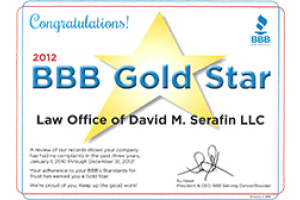Chapter 13 Bankruptcy may Remove Second Mortgage
November 7, 2011
By: David M. Serafin
Despite the fact the home values in the Denver metro area and most of Colorado have plummeted, chapter 13 bankruptcy may allow for the complete removal of a second mortgage or Home Equity Line of Credit (HELOC) and the accompanying higher interest rate than is typically paid on a first lien. Although Congress has repeatedly disallowed the cram down of the principal balance owed on a first mortgage in bankruptcy, Section 506 of the United States Bankruptcy Code allows for eligible struggling homeowners, who are underwater on a first mortgage and making payments on a property worth less than what is owed, to eliminate the second mortgage in chapter 13.
The second mortgage is then rendered unsecured (similar to credit card debt or debt from medical bills) and the debtor pays back anywhere from none to all of this debt, depending on the outcome of the Means Test. The Means Test determines the percentage of unsecured debt, including the stripped off second mortgage, will be paid back to creditors, so higher income chapter 13 filers – who are required to pay back 100% to creditors in the plan – will not benefit from Section 506. Conversely, passing the Means Test completely usually means paying nothing back for credit card, medical bill or to any unsecured creditors.
For example, consider a situation where a single bankruptcy filer owns a house valued at $300,000 with first and second mortgage balances of $320,000 and $40,000, respectively. Section 506 allows for the removal of the second mortgage lien so long as the debtor subsequently completes the three to five year chapter 13 plan. (The monthly plan payments, and the duration of the plan payments, are determined by the debtor’s income, expenses and household size under the Means Test.)
Here’s how the process works in Colorado: a chapter 13 bankruptcy is filed with a proposed re-payment plan to creditors. Before the plan is court approved (referred to as plan confirmation), a Section 506 Motion to Determine Secured Status is filed, with the most recent mortgage statements and a written property valuation attached as exhibits, and served to the president, CEO or an officer of the company. The loan servicer for the second lien has 28 days to object. If the re-payment plan is approved by the Bankruptcy Court, the court will also strip off the homeowner’s second mortgage conditioned upon eventual completion of the plan payments to creditors.
Note that Section 506 is an “all or nothing” provision in that the property value has to be less than the first mortgage balance (e.g. the second mortgage is entirely unsecured) as of the date of the bankruptcy filing. If the first mortgage balance is slightly higher than the value listed by the realtor, the second mortgage holder will likely object and contest the property value in court. (Another scenario is to renegotiate the loan agreeing to partial reduction of the second mortgage if the numbers are close and if neither party wants to risk an adverse judgment in court.)
Another benefit of wiping out the second mortgage is that the homeowner may gain equity if the property value increases down the road and the money saved will help keep the first mortgage current.
As a Denver consumer bankruptcy lawyer assisting people with chapter 13, the Law Office of David M. Serafin will advise as to whether you are eligible to remove a second mortgage in bankruptcy.





